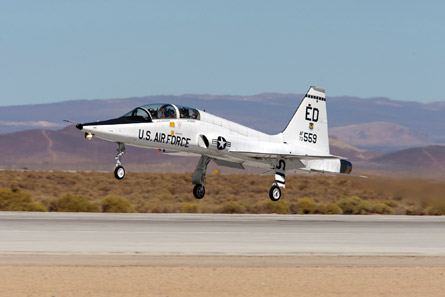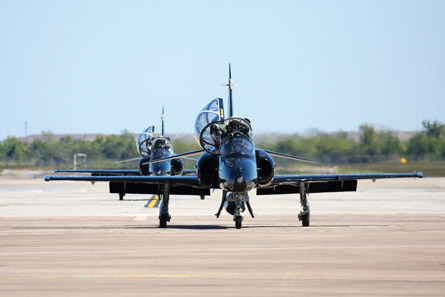With the US military facing lean times, the US Air Force's Air Education and Training Command (AETC) is not immune from procurement pressure, despite its importance in providing the combat pilots of the future.
AETC chief Gen Edward Rice imposed a new "culture of cost consciousness" in a 12 January speech, calling on his employees to individually pose such mindful questions as whether they turned off the lights when they left the office, or if they really need to keep a dozen government-funded pens and pencils inside their desks.
Not surprisingly, more expensive bills, such as replacing the command's fleet of 508 ageing Northrop T-38 Talon jet trainers, are also receiving sharper scrutiny by Rice and his superiors in the air force chief of staff's office.
 |
|---|
© runlikehell/AirSpace The USAF has a fleet of 508 T-38s |
Rice's predecessor, Gen Stephen Lorenz, had unveiled a plan three years ago to award a contract for at least 350 new jets in late 2014. Under his plan, the first training unit for future fighter and bomber pilots to be equipped with the new aircraft would field the type in 2017.
The prospect of selling hundreds of aircraft in an otherwise bleak sales environment attracted at least four bidders, including a T-100 variant of the Alenia Aermacchi M-346, the BAE Systems T129 Hawk, Lockheed Martin/Korea Aerospace Industries T-50 and perhaps a new, purpose-built aircraft designed by Boeing.
However, the USAF leadership failed to make a strong commitment to invest in the programme. The T-X advanced pilot trainer never made the list of the service's top three acquisition priorities, which have exclusively included a new bomber, the Lockheed F-35A Lightning II and the Boeing KC-46A tanker.
In a February 2011 interview, Rice declined to specifically commit to keeping the in-service date in fiscal year 2017 as scheduled.
Then, in November, the AETC announced air force and Department of Defense budgets planners were, in fact, considering delaying the in-service date for T-X because of "budget constraints". No details were provided.
Finally, in early February 2012, the AETC confirmed a three-year delay to the initial operational capability (IOC) of the T-X fleet, stretching the schedule to begin replacing the T-38 from FY2017 to FY2020. At the same time, the USAF reduced the total T-X budget from FY2013 to FY2016 to $82.9 million, a 70.1% cut.
The AETC also initially said contract award had slipped by one year, but was mistaken. Subsequent budget documents have revealed there is no change in original contract award date, which is at the end of September 2014.
The six-year period between contract award and the IOC date presents potential bidders with a puzzling dilemma, as the same USAF budget documents that call for this gap also describe the T-38's future replacement as a non-developmental, off-the-shelf aircraft. The air force is aware that three advanced jet trainers are already in production.
The USAF has not explained why it still needs to award the development contract so far ahead of the entry-into-service date, if there is so little development that needs to be done.
 |
|---|
© Kevin Hong/BAE Systems BAE Systems ahs pitched its T129 Hawk for the requirement |
The bidders' confusion is perhaps illustrated by their varying public approaches to the nascent competition.
So far, BAE has led the most pronounced sales campaign in the bidding process. As an ongoing "road show" directly exposes the Hawk to the USAF pilot community, BAE has announced Northrop Grumman and L-3 Link Simulation & Training as major partners in the bid.
Alenia, meanwhile, has called the T-X bid a strategic opportunity, which allows it to offer the M-346 rebranded as the T-100. In January, Alenia demonstrated how the T-100 ground-based training system can be networked with software developed by CAE to the Hawker Beechcraft T-6 Texan II primary trainer already in USAF service.
Both Lockheed and Boeing, meanwhile, have taken a less aggressive position in the competition. Both companies have displayed images of their concepts at major USAF events, but have announced no major partnerships or demonstrations specifically tied to the T-X campaign.
The companies may have plenty of time to wait for the USAF to clarify the long gap in the acquisition schedule.
Meanwhile, the USAF has launched the Pacer Classic III structural retrofit programme for the T-38C. It is targeted at preserving the airworthiness of 125 T-38Cs, which are at high risk of grounding during the next eight years. After the retrofits are complete, the T-38 fleet is expected to remain airworthy until 2026.
Source: Flight International



















